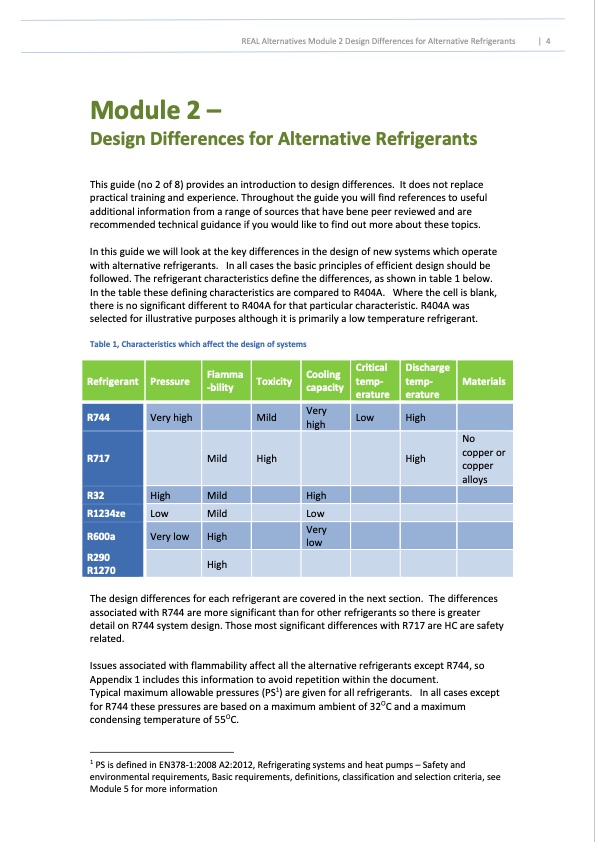
PDF Publication Title:
Text from PDF Page: 004
REAL Alternatives Module 2 Design Differences for Alternative Refrigerants | 4 Module 2 – Design Differences for Alternative Refrigerants This guide (no 2 of 8) provides an introduction to design differences. It does not replace practical training and experience. Throughout the guide you will find references to useful additional information from a range of sources that have bene peer reviewed and are recommended technical guidance if you would like to find out more about these topics. In this guide we will look at the key differences in the design of new systems which operate with alternative refrigerants. In all cases the basic principles of efficient design should be followed. The refrigerant characteristics define the differences, as shown in table 1 below. In the table these defining characteristics are compared to R404A. Where the cell is blank, there is no significant different to R404A for that particular characteristic. R404A was selected for illustrative purposes although it is primarily a low temperature refrigerant. Table 1, Characteristics which affect the design of systems Refrigerant Pressure Flamma ‐bility Toxicity Cooling capacity Critical temp‐ erature Discharge temp‐ erature Materials R744 Very high Mild Very high Low High R717 Mild High High No copper or copper alloys R32 High Mild High R1234ze Low Mild Low R600a Very low High Very low R290 R1270 High The design differences for each refrigerant are covered in the next section. The differences associated with R744 are more significant than for other refrigerants so there is greater detail on R744 system design. Those most significant differences with R717 are HC are safety related. Issues associated with flammability affect all the alternative refrigerants except R744, so Appendix 1 includes this information to avoid repetition within the document. Typical maximum allowable pressures (PS1) are given for all refrigerants. In all cases except for R744 these pressures are based on a maximum ambient of 32OC and a maximum condensing temperature of 55OC. 1 PS is defined in EN378‐1:2008 A2:2012, Refrigerating systems and heat pumps – Safety and environmental requirements, Basic requirements, definitions, classification and selection criteria, see Module 5 for more informationPDF Image | Alternative Refrigerants

PDF Search Title:
Alternative RefrigerantsOriginal File Name Searched:
RealAlternatives-2-Design-differences-Feb15.pdfDIY PDF Search: Google It | Yahoo | Bing
CO2 Organic Rankine Cycle Experimenter Platform The supercritical CO2 phase change system is both a heat pump and organic rankine cycle which can be used for those purposes and as a supercritical extractor for advanced subcritical and supercritical extraction technology. Uses include producing nanoparticles, precious metal CO2 extraction, lithium battery recycling, and other applications... More Info
Heat Pumps CO2 ORC Heat Pump System Platform More Info
| CONTACT TEL: 608-238-6001 Email: greg@infinityturbine.com | RSS | AMP |